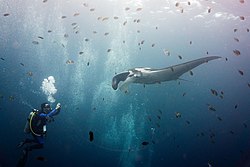Organization:Manta Matcher
| Legal status | nonprofit |
|---|---|
| Purpose | Online citizen science database to identify and track manta rays |
Parent organization | Marine Megafauna Foundation, WildMe |
| Website | https://www.mantamatcher.org |
Manta Matcher is a global online database for manta rays.[1]
Creation
It is one of the Wildbook Web applications developed by Wild Me, a 501(c)(3) not-for-profit organization in the United States, and was created in partnership with Andrea Marshall of the Marine Megafauna Foundation.
Manta rays have unique spot patterning on their undersides, which allows for individual identification.[2] Scuba divers around the world can photograph mantas[3] and upload their manta identification photographs to the Manta Matcher website,[4] supporting global research and conservation efforts.
Identification of rays
Manta Matcher is a pattern-matching software that eases researcher workload; key spot pattern features are extracted using a scale-invariant feature transform (SIFT) algorithm,[5] which can cope with complications presented by highly variable spot patterns and low contrast photographs.
Purpose and research supported
This citizen science tool is free to use by researchers worldwide. Manta Matcher represents a global initiative to centralize manta ray sightings and facilitate research on these vulnerable species through collaborative studies, including the cross-referencing of regional databases.[6]
Manta Matcher has already supported research[7] that contributed to the listing of reef mantas (Manta alfredi) on Appendix 1 of the Convention on Migratory Species in November 2014.[8]
References
- ↑ Town, Christopher; Marshall, Andrea; Nutthaporn, Sebastien (2013). "Manta Matcher: automated photographic identification of manta rays using keypoint features". Ecology and Evolution 3 (7): 1902–1914. doi:10.1002/ECE3.587. PMID 23919138.
- ↑ Marshall, A.D.; Dudgeon, C.L.; Bennett, M.B. (2011). "Size and structure of a photographically identified population of manta rays Manta alfredi in southern Mozambique". Marine Biology 158 (5): 1111–1124. doi:10.1007/s00227-011-1634-6.
- ↑ "Photographing Mantas". http://www.mantamatcher.org/photographing.jsp.
- ↑ "Participate: Report an Encounter". http://mantamatcher.org/submit.jsp.
- ↑ Town, Christopher; Marshall, Andrea; Nutthaporn, Sebastien (2013). "Manta Matcher: automated photographic identification of manta rays using keypoint features". Ecology and Evolution 3 (7): 1902–1914. doi:10.1002/ECE3.587. PMID 23919138.
- ↑ Steinhoff, Nane (2023-01-10). "First international migration of manta rays confirmed" (in en-GB). https://oceanographicmagazine.com/news/first-international-migration-of-manta-rays-confirmed/.
- ↑ Germanov, Elitza; Marshall, Andrea (2014). "Running the Gauntlet: regional movement patterns of Manta alfredi through a complex of parks and fisheries". PLOS ONE 9 (10): e110071. doi:10.1371/journal.pone.0110071. PMID 25337865. Bibcode: 2014PLoSO...9k0071G.
- ↑ "31 Species of Migratory Animals Given UN Protection". Sydney Morning Herald. November 10, 2014. http://www.smh.com.au/environment/conservation/31-species-of-migratory-animals-given-un-protection-20141110-11js7y.html.
External links
 |


